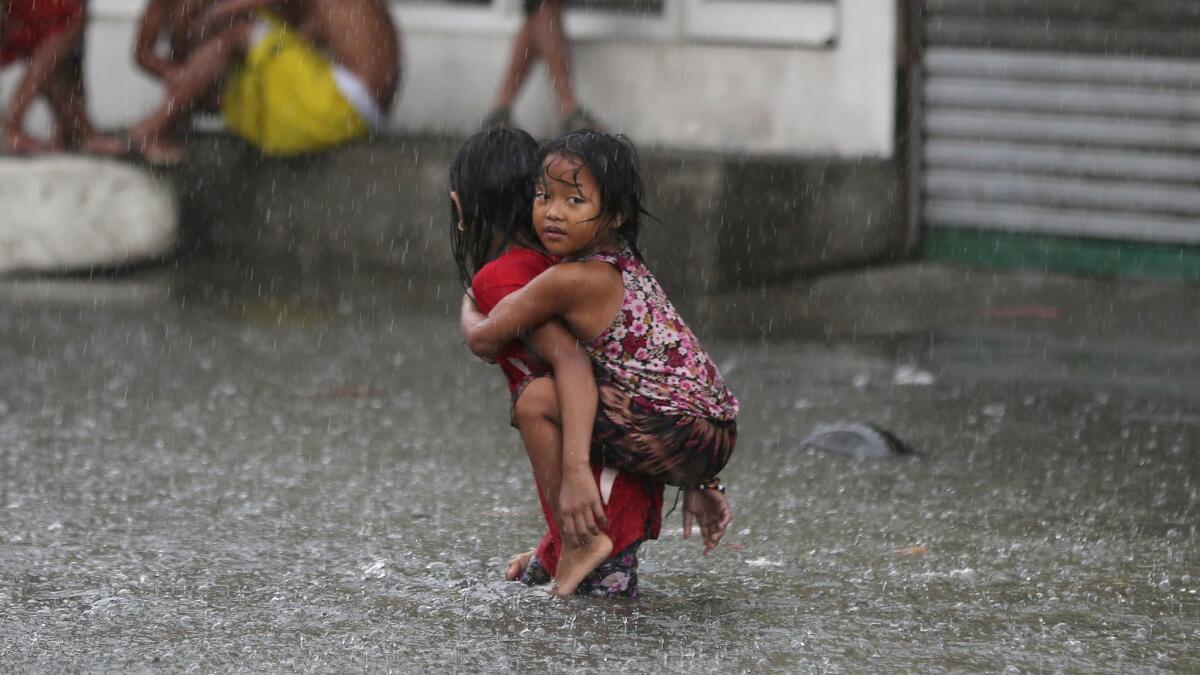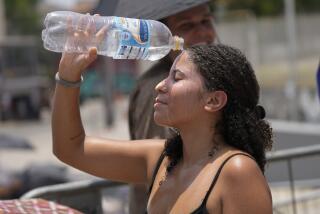Even with pledges to fight global warming, you’d better brace yourself for more extreme weather

Scientists have some sobering news about the future of our planet: Even if humans manage to meet the temperature target set forth in the Paris climate change agreement, record-breaking weather events will become increasingly common around the world.
And that’s the good part.
The Paris plan seeks to keep Earth’s global average temperature within 2 degrees Celsius of pre-industrial levels by getting people to reduce their carbon emissions. According to the United Nations, 174 countries have signed on to the agreement.
However, the actual commitments made by these countries would probably allow the global average temperature to rise by as much as 3 degrees Celsius. In that case, extreme weather events would become much more commonplace almost everywhere on the planet.
With the pledges currently in place, we’re likely to see “substantial and widespread increases in the probability of historically unprecedented extreme events,” researchers wrote Wednesday in the journal Science Advances. The effects of this extreme weather will be seen “across human and natural systems, including both wealthy and poor communities,” they added.
The research team, led by Stanford University climate scientist Noah Diffenbaugh, considered eight types of extreme weather events. These included the hottest maximum daily temperature of the year, the warmest minimum daily temperature of the year, the number of days in a year when the temperature remained below freezing, the wettest day of the year and the longest consecutive dry spell.
Historical data for these events and more were available from the Climdex project. Diffenbaugh and his co-authors — Deepti Singh of Columbia University’s Lamong-Doherty Earth Observatory and Justin Mankin of Dartmouth College — combined that data with various climate models to make predictions about frequency of extreme weather events under different global warming scenarios.
Here’s a sampling of what they found:
The more the global temperature rises, the greater the odds of extremely wet weather. That means more days with record-setting amounts of precipitation. It also means greater amounts of precipitation on the wettest days of the year.
In some parts of the world, rising temperatures will fuel an increase in extremely dry weather events, but in areas that are more geographically concentrated.
The carbon emissions produced by humans have already made days with record-setting high temperatures more common throughout the globe. The researchers documented this trend in 71% of places in North America where records have been kept. They also saw it in 56% of places in East Asia, 77% of places in Europe, 82% of places in Australia and 85% of places in South America.
Even more common were new records for high temperatures at night. Throughout North America, Europe, Australia and southern South America, at least 90% of locations for which data were available have been setting nighttime heat records with increasing frequency.
The higher the average temperature goes, the more often heat records will be broken.
Consider Europe. If the world succeeds in keeping global warming to within 1 to 2 degrees Celsius, about 8% of the European locations studied would at least triple their likelihood of setting new records for daily high temperature. If the planet heats by 2 to 3 degrees C, about 52% of Europe could expect the same increase.
At least 70% (and up to 91%) of locations in North America, Europe, East Asia, southern South America and Australia are already experiencing more extremely wet weather events thanks to human-caused global warming.
If temperatures stay within the hoped-for limits of the Paris accord, 96% of locations in Europe, 97% of those in North America and 100% of those in East Asia would break records for the amount of precipitation in the year’s wettest days more often. In addition, between 93% and 95% of locations in North America, Europe, East Asia and Australia would set more records for the wettest day of the year.
If temperatures exceed the Paris goals, things would get slightly worse. Notably, all locations in Europe, East Asia and Australia would see more days that break records for total precipitation, as would 98% of locations in North America.
In Australia and southern South America, higher temperatures would lead to more records for the longest dry spell and the driest year overall. However, in North America, Europe and East Asia, the wetter weather that comes with higher temperatures would make extremely dry events less likely.
Still, the researchers warned that historically dry conditions would become more common in “heavily populated and highly vulnerable” regions, including the Mediterranean, southern Africa and Southeast Asia.
The researchers did not have the data they needed to make forecast for areas in the tropics. However, they noted that this region — which is both heavily populated and lacking in resources needed to adapt to climate change — has already seen a big jump in temperatures over the historical variations.
Using alternative methods to estimate the effects in tropical South America and tropical Africa, the study authors predicted that if average global temperatures were to rise by 2 to 3 degrees Celsius, the incidence of days with record heat or record precipitation would be more than five times greater than the historical average while the incidence of driest years and longest dry spells will triple.
Before the Paris accord was reached, the planet was on track to see its global average temperature rise by 4 degrees Celsius, Diffenbaugh said. That means the current commitments to reduce emissions are helping, even if they aren’t yet enough to cap the increase at 2 degrees C.
The study confirms that 1 degree C of warming has happened already, and that it has coincided with an increased risk of all kinds of extreme weather.
As for what comes next, we’ll just have to wait and see.
“I am not in a position to predict what countries or individuals will do,” Diffenbaugh said.
Follow me on Twitter @LATkarenkaplan and “like” Los Angeles Times Science & Health on Facebook.
MORE IN SCIENCE
Scientists take an atomic clock on the road and use it to measure the height of a mountain
In soil-dwelling bacteria, scientists find a new weapon to fight drug-resistant superbugs
Trump’s budget would kill NASA’s WFIRST telescope. Astronomers say that would be a mistake







